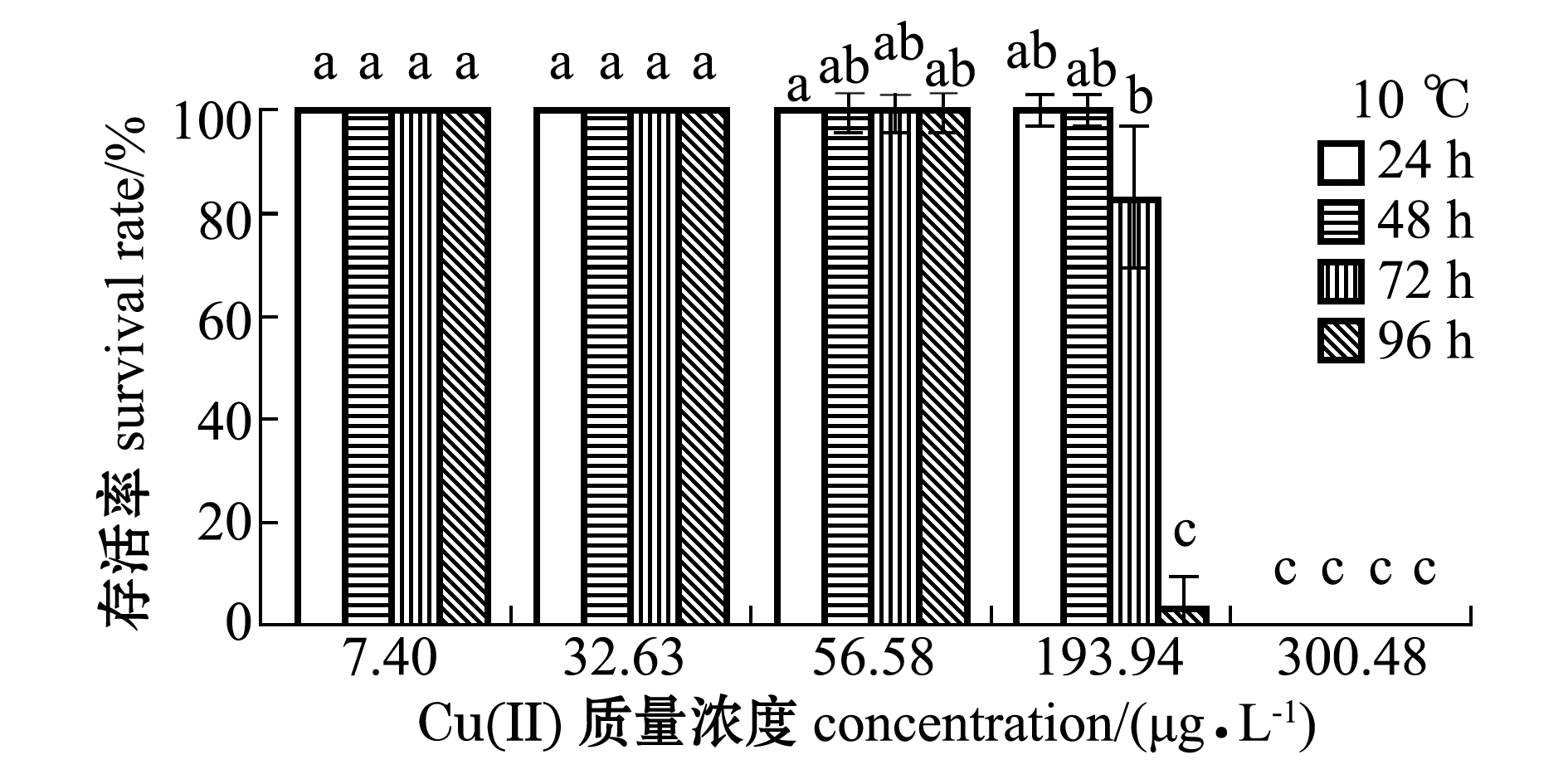
摘要:进行了不同温度 (10、14、17 ℃)和不同Cu(Ⅱ)质量浓度 (7.40、32.63、56.58、193.94、300.48 μg/L)的耦合作用对厚壳贻贝MytiluscoruscusD形幼虫生长和存活的急性毒性影响试验。结果表明:Cu(Ⅱ)胁迫96 h后,10、14 ℃试验组幼虫的存活率在Cu(Ⅱ)质量浓度为193.94、300.48 μg/L时均显著降低(P<0.05),17 ℃试验组幼虫的存活率在Cu(Ⅱ)质量浓度为56.58 μg/L及以上时显著降低(P<0.05);在温度为10、14、17 ℃时Cu(Ⅱ)胁迫的96 h半致死浓度(96 h LC50)分别为143.6、143.5、133.0 μg/L,表明随着温度的升高LC50呈下降趋势;Cu(Ⅱ)胁迫96 h的生长试验结果显示,在10 ℃时,56.58 μg/L质量浓度组的壳长相对增长率与对照组存在显著性差异(P<0.05),14、17 ℃时,32.63、56.58 μg/L质量浓度组的壳长相对增长率与对照组存在显著性差异(P<0.05);在相同Cu(Ⅱ)浓度和不同水温胁迫下,17 ℃试验组幼虫壳长相对增长率显著高于10、14 ℃试验组(P<0.05)。研究表明,Cu(Ⅱ)胁迫和温度的变化能影响厚壳贻贝D形幼虫的存活,且在较高的温度下幼虫对Cu(Ⅱ)胁迫更为敏感。
关键词:厚壳贻贝;铜;温度;D形幼虫;半致死浓度;生长
过去几十年间,人类活动的急剧增加已导致了环境中重金属含量不断上升[1]。铜是软体动物生长所须的微量元素,但在过量的情况下其对生物体具有毒性[2-4]。在自然海洋环境中,Cu(Ⅱ)质量浓度通常低于5 μg/L,而在被污染的海域能高达800~1000 μg/L[5]。海洋中Cu(Ⅱ)污染的严重性已引起了人们的广泛关注和重视。双壳类动物不但易于采集,而且对环境污染物很敏感并能作出快速的反应[6-8],所以经常被用于监测海洋环境或养殖水体环境污染的情况。
厚壳贻贝Mytiluscoruscus为中国重要的贝类养殖品种,也是主要的筏式养殖贝类之一,其分布于黄海、渤海和东海沿岸[9],其中以浙江沿海资源量最大。近年来,人为过度采捕导致厚壳贻贝自然资源逐渐减少,同时由于环境的污染和生态的破坏,使厚壳贻贝养殖产业受到严重影响。
有关Cu(Ⅱ)对海洋无脊椎动物毒性的研究已有许多报道,而Cu(Ⅱ)对厚壳贻贝早期幼虫的急性毒性却鲜有报道。为了有效地评估Cu(Ⅱ)的毒性大小和厚壳贻贝对Cu(Ⅱ)胁迫的敏感程度,本研究中利用东海区的常见种厚壳贻贝作为受试生物,研究了不同温度 (10、14、17 ℃)和Cu(Ⅱ)质量浓度 (7.40、32.63、56.58、193.94、300.48 μg/L)的耦合作用对厚壳贻贝D形幼虫生长和存活的影响,旨在为该种的水产养殖提供科学参考,也为环境保护及污染检测提供理论依据。
1.1材料
1.1.1 受试生物 成体厚壳贻贝采自浙江省嵊泗县枸杞岛附近海域,依照Yang等[10]的方法进行人工授精和幼虫培育。试验过程中,使用受精卵孵化后4 日龄的D形幼虫,其壳长为(81.1± 4.2)μm,壳高为(59.5± 4.6)μm。
1.1.2 试验用水及药品 试验用水取自浙江省嵊泗县枸杞岛海域,盐度为30,pH为8.11,铵态氮和亚硝酸氮含量分别为0.0012、0.0110 mg/L。CuCl2·2H2O(AR)购自于上海国药集团化学试剂有限公司,用GF/C滤膜(Whatman玻璃纤维滤膜,孔径为1.2 μm)过滤的海水配制成含Cu(Ⅱ)质量浓度为10 mg/L的母液,测试溶液按要求进行稀释。
1.2方法
试验在黑暗条件下进行,设制10、14、17 ℃ 3个温度,每个温度下均设4个Cu(Ⅱ)质量浓度组(10、50、100、300 μg/L)和1个对照组,每个试验设3个平行组,并进行3次重复试验。Cu(Ⅱ)质量浓度的测定采用TAS990 原子吸收分光光度计,实际测试质量浓度分别为7.40(对照)、32.63、56.58、193.94、300.48 μg/L。
(1)存活试验。存活试验在玻璃培养皿(64 mm×19 mm)内进行,每一培养皿放入20 mL由灭菌海水配制的Cu(Ⅱ) 溶液,随机选取20只D形幼虫放入。每隔24 h换水1次,换水后Cu(Ⅱ)质量浓度不变,试验过程中不投饵。
(2)生长试验。每个质量浓度组放100只幼虫进行生长试验。每隔24 h测量各质量浓度组幼虫的壳长和壳高,并记录各组幼虫在1、3、6、10、24、48、72、96 h的死亡数。幼虫的死亡标准为在显微镜下观察到幼虫静止不动,双壳张开,多次刺激无反应。
1.3数据处理
试验数据均用平均值±标准差表示(mean±S.D.)。采用SPSS 17软件进行统计分析,通过单因素和双因素方差分析(ANOVA)处理相关数据,显著性水平设为0.05。用直线内插法计算厚壳贻贝D形幼虫的半致死浓度(LC50),并采用公式SC=0.01×96 h LC50计算安全浓度。
2.1不同温度下Cu(Ⅱ)对D形幼虫存活的影响
10 ℃时,对照组和32.63、56.58、193.94 μg/L Cu(Ⅱ)质量浓度组,所有幼虫直到10 h均存活且处于游泳状态,而300.48 μg/L质量浓度组幼虫10 h后存活率显著下降 (P<0.05),仅为24%。从图1可见:Cu(Ⅱ)中暴露96 h时,32.63、56.58 μg/L质量浓度组幼虫的存活率高于95%,193.94 μg/L质量浓度组的存活率仅为3%,而300.48 μg/L质量浓度组幼虫在24 h后全部死亡。多重比较结果表明:193.94 μg/L质量浓度组幼虫在96 h时的存活率较3个低浓度组显著下降(P<0.05);300.48 μg/L质量浓度组幼虫的存活率较其他浓度组显著下降(P<0.05)。
14 ℃时,10 h内除300.48 μg/L质量浓度组外,对照组和32.63、56.58、193.94 μg/L质量浓度组均无幼虫死亡。在Cu(Ⅱ)中暴露96 h时,32.63、56.58 μg/L质量浓度组幼虫全部存活,且呈快速游动的状态;在193.94、300.48 μg/L质量浓度组幼虫的存活率随着在Cu(Ⅱ)中暴露时间的延长而持续下降,96 h时分别为2%和0%。多重比较结果表明:193.94 μg/L质量浓度组幼虫在72 h后的存活率较3个低浓度组显著下降(P<0.05);300.48 μg/L质量浓度组幼虫的存活率较其他浓度组均显著下降(P<0.05)。

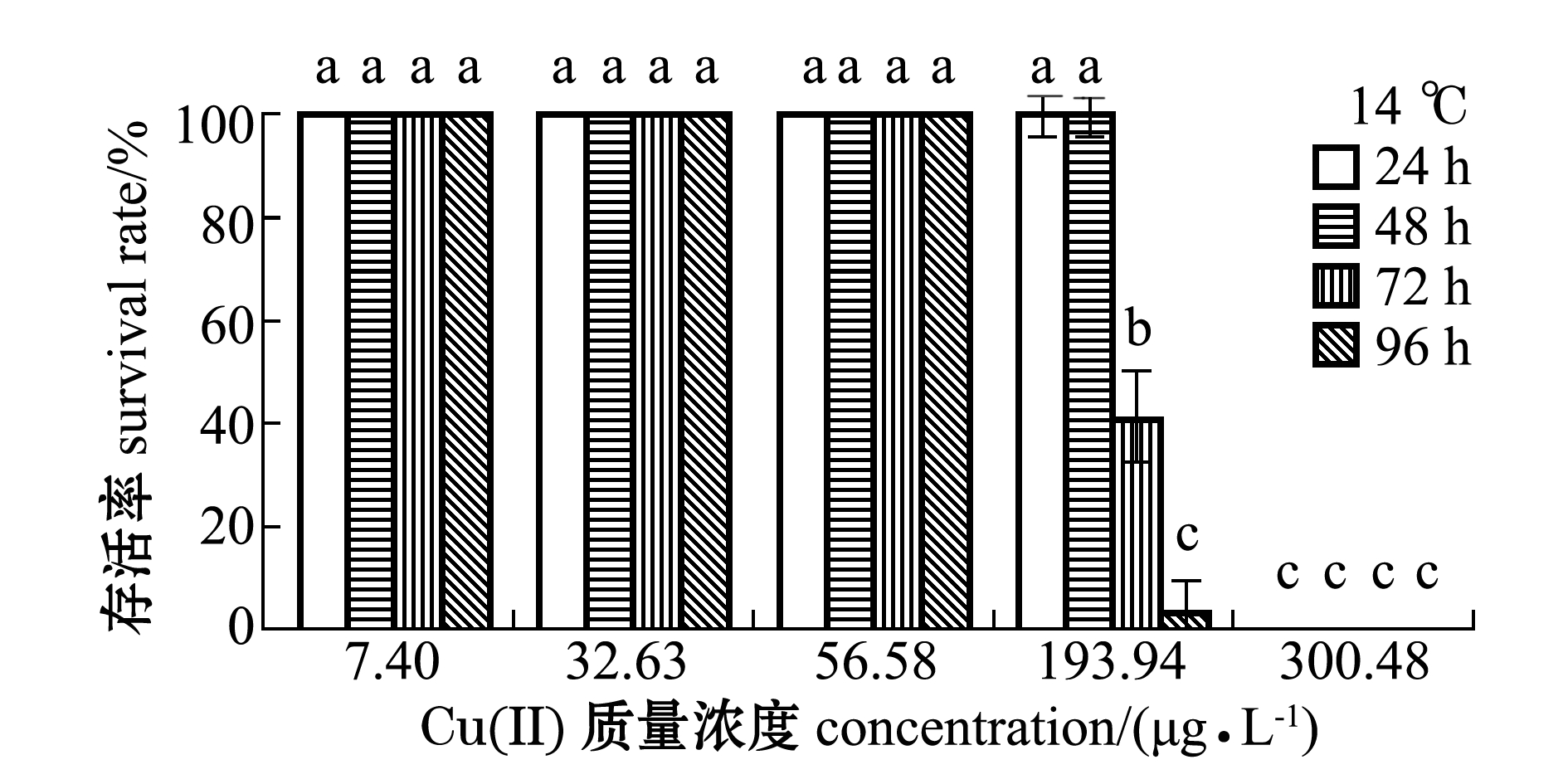
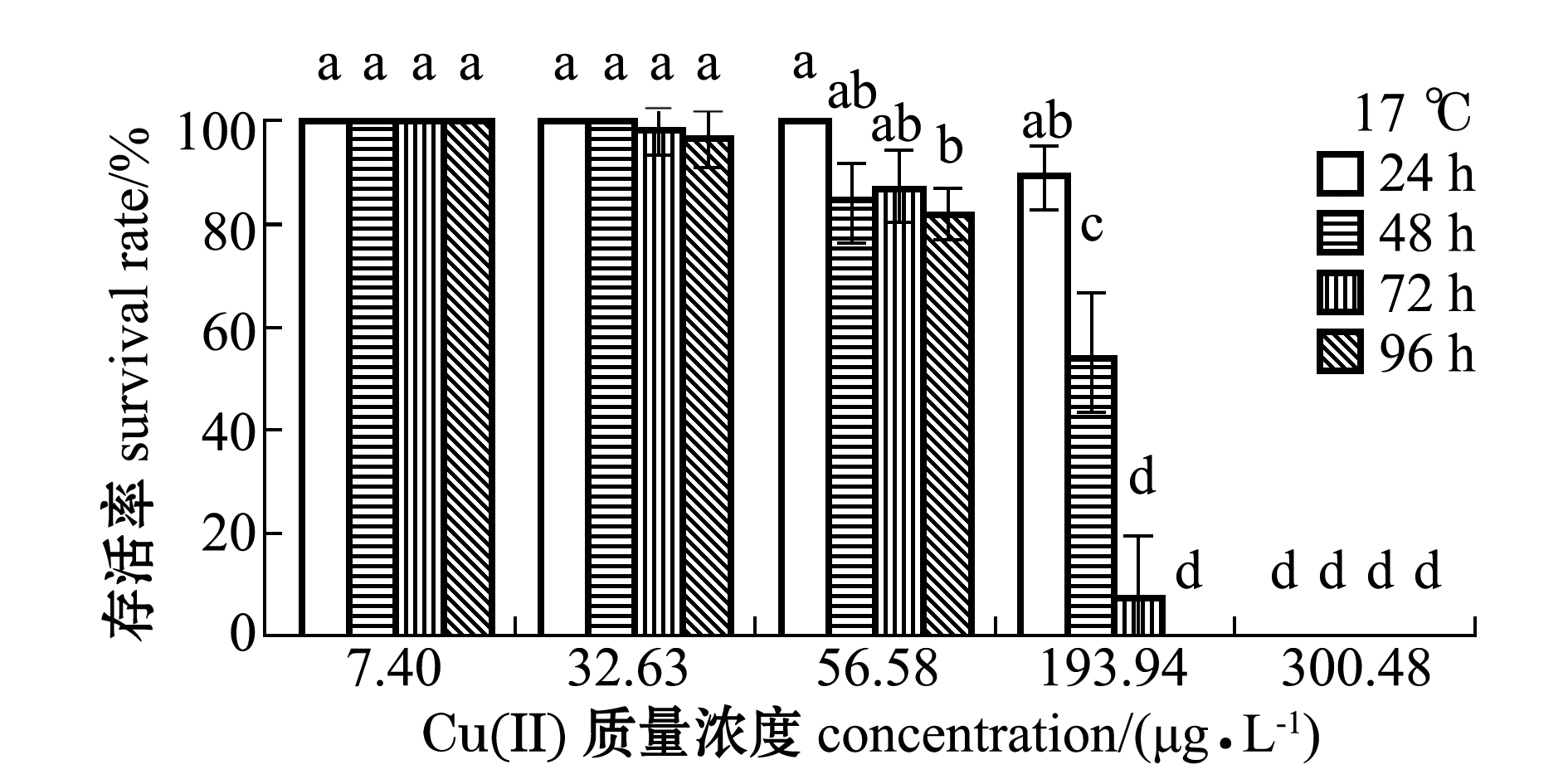
注:同一时间下,标有不同小写字母者表示不同浓度组间有显著性差异(P<0.05),标有相同小写字母者表示不同浓度组间无显著性差异(P>0.05),下同
Note:The means with different letters in same time are significant differences at the 0.05 probability level at different concentrations, and the means with the same letters are not significant differences, et sequentia
图1 不同温度下Cu(Ⅱ)质量浓度对厚壳贻贝D形幼虫存活率的影响
Fig.1 Survival rates of mussel Mytilus coruscus larvae exposed to copper(Ⅱ) at different temperature
17 ℃时,10 h内对照组和32.63、56.58、193.94 μg/L质量浓度组均无幼虫死亡,300.48 μg/L质量浓度组6 h和10 h时幼虫的存活率分别降至6%和0%。在Cu(Ⅱ)中暴露96 h时,32.63 μg/L质量浓度组有3%的幼虫死亡,56.58 μg/L质量浓度组有近20%的幼虫死亡,193.94 μg/L质量浓度组48 h时的存活率显著降低(P<0.05),并且在96 h全部死亡。多重比较结果表明:193.94 μg/L质量浓度组幼虫在48 h后的存活率较3个低浓度组显著下降(P<0.05);300.48 μg/L质量浓度组幼虫的存活率较其他浓度组显著下降(P<0.05)。
Cu(Ⅱ)和温度的双因素方差分析结果表明,96 h后温度、Cu(Ⅱ)质量浓度及其交互作用均极显著影响幼虫的存活率(P<0.05)(表1)。
表1 96h时Cu(Ⅱ)质量浓度和温度对厚壳贻贝D形幼虫毒性影响的双因子方差分析结果
Tab.1Two-factoranalysisofvarianceoftheeffectsofcopper(Ⅱ)concentrationandwatertemperatureonthesurvivalratesofmusselMytiluscoruscusD-veligerlarvaein96h

因子factor自由度df平方和SSF值P值Cu(Ⅱ)浓度copperconcentration4233708 203045 21<0 001温度temperature21506 0139 25<0 001Cu(Ⅱ)×温度Cu(Ⅱ)×temperature82386 3915 55<0 001
根据幼虫在不同温度、不同质量浓度Cu(Ⅱ)胁迫下的试验结果,计算得到Cu(Ⅱ)对厚壳贻贝D形幼虫的LC50如表2示。从表2可见:随着温度的升高LC50不断降低,在48 h时,17 ℃组的LC50仅为171.1 μg/L,远低于10、14 ℃组;在96 h时,17 ℃组的LC50最小,仅为133.0 μg/L。推算得到,Cu(Ⅱ)胁迫下厚壳贻贝D形幼虫在10、14、17 ℃时的安全浓度(SC)分别为14.36、14.35、13.30 μg/L。
表2厚壳贻贝D形幼虫在不同温度下的半致死浓度
Tab.2LC50ofmusselMytiluscoruscusexposedtocopperatdifferenttemperatures
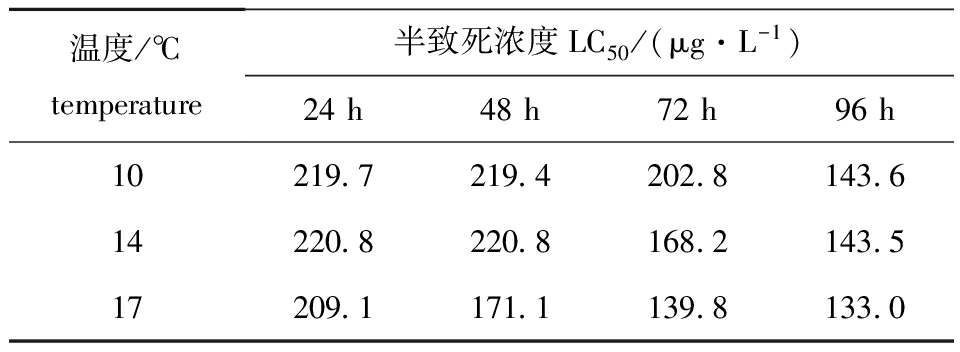
温度/℃temperature半致死浓度LC50/(μg·L-1)24h48h72h96h10219 7219 4202 8143 614220 8220 8168 2143 517209 1171 1139 8133 0
2.2不同温度下Cu(Ⅱ)对D形幼虫生长的影响
D形幼虫暴露于不同质量浓度的Cu(Ⅱ)下,其壳长的生长及相对增长率分别如图2和表3所示。从图2可见:17 ℃时193.94 μg/L质量浓度组暴露72 h后以及10、14、17 ℃时300.48 μg/L质量浓度组,暴露96 h后幼虫全部死亡,故没有幼虫壳长生长的数据。从表3可见:暴露48 h,10、14、17 ℃时不同Cu(Ⅱ)质量浓度下幼虫的壳长相对增长率均无显著性差异(P>0.05);暴露96 h时,3种水温下随着Cu(Ⅱ)质量浓度的增加,幼虫的壳长相对增长率基本呈下降趋势,且在同一质量浓度下,17 ℃ 组幼虫的壳长相对增长率显著高于10、14 ℃组(P<0.05),在32.63 μg/L质量浓度下,10、14 ℃两组壳长相对增长率间有显著性差异(P<0.05),在其他浓度下均无显著性差异(P>0.05)。
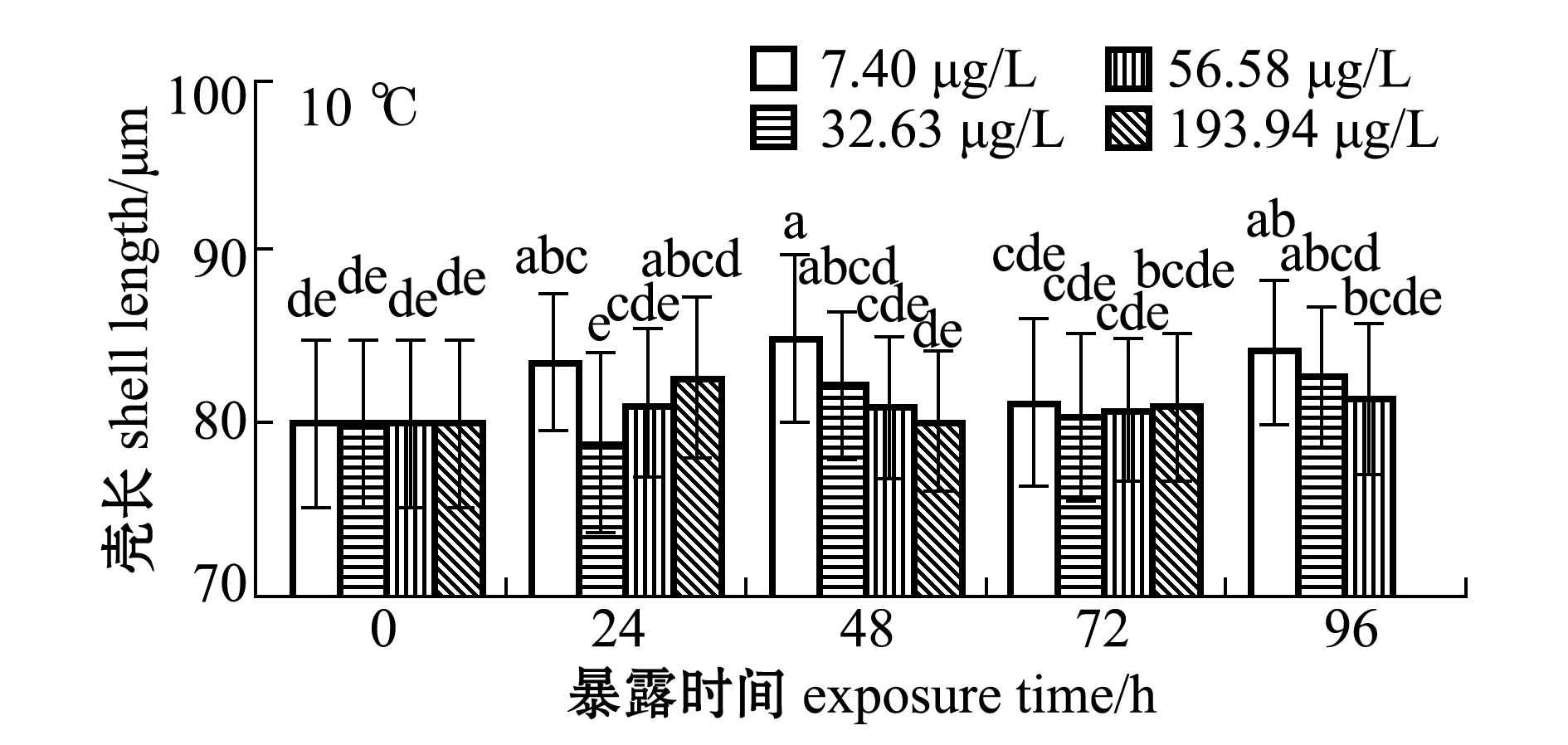
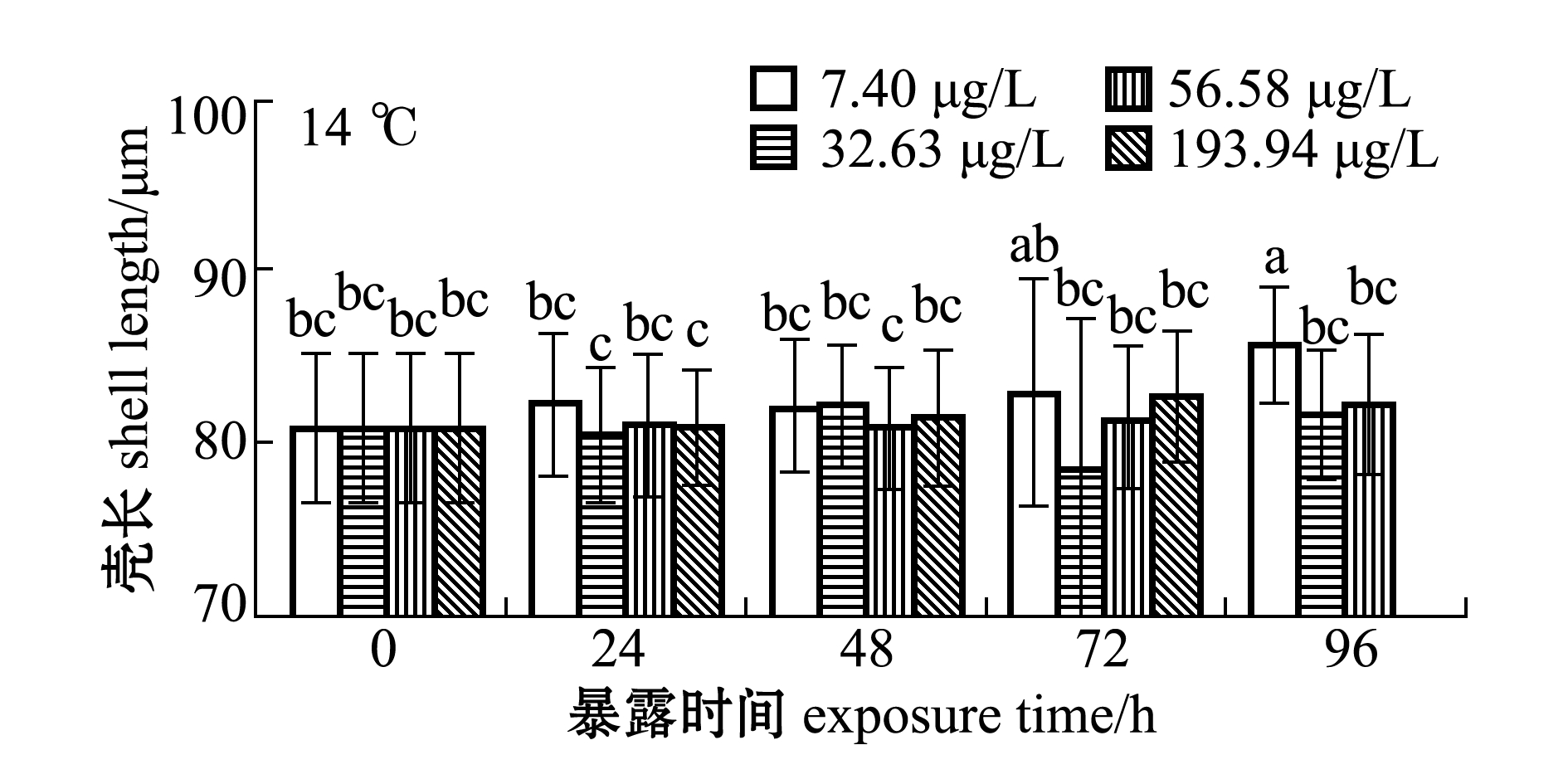
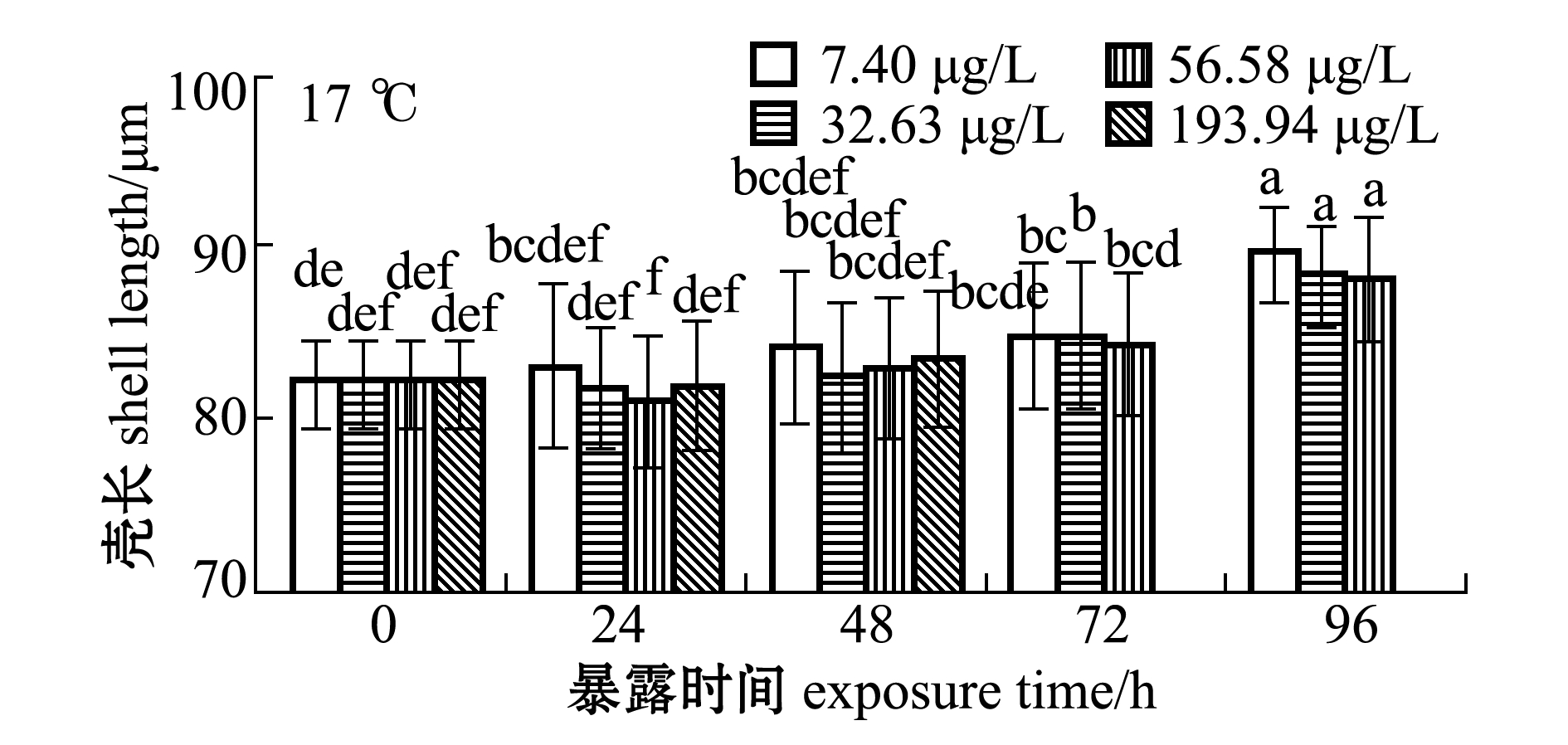
图2 不同温度下Cu(Ⅱ)质量浓度对D形幼虫壳长生长的影响
Fig.2 Shell length growth of mussel Mytilus coruscus larvae exposed to copper(Ⅱ) at different temperature
表3Cu(Ⅱ)暴露下D形幼虫壳长的相对增长率
Tab.3RelativegrowthratesinshelllengthofmusselMytiluscoruscusD-veligerlarvaeexposedtocopper(Ⅱ)atdifferenttemperature
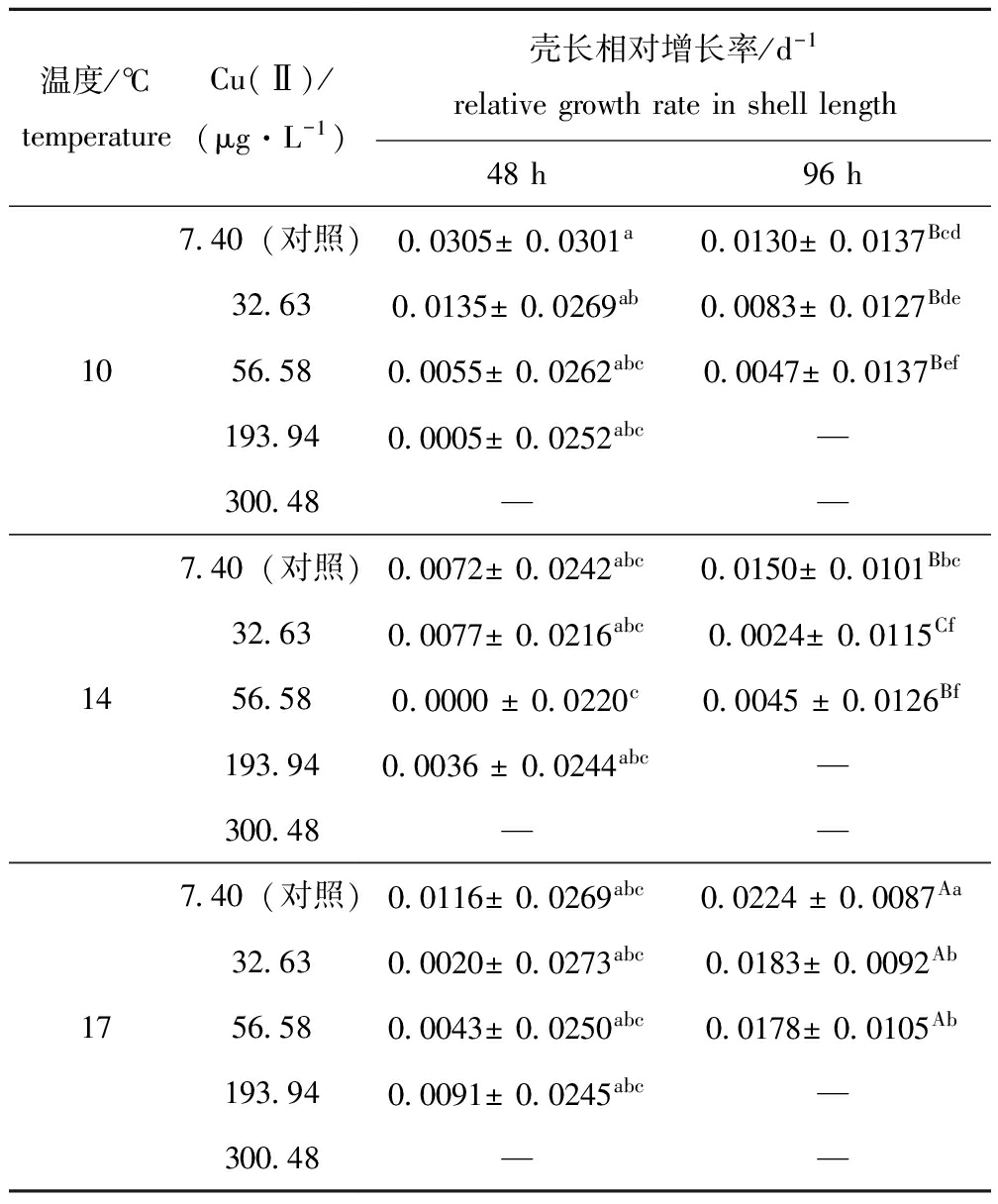
温度/℃temperatureCu(Ⅱ)/(μg·L-1)壳长相对增长率/d-1relativegrowthrateinshelllength48h96h7 40(对照)0 0305±0 0301a0 0130±0 0137Bcd32 630 0135±0 0269ab0 0083±0 0127Bde1056 580 0055±0 0262abc0 0047±0 0137Bef193 940 0005±0 0252abc—300 48——7 40(对照)0 0072±0 0242abc0 0150±0 0101Bbc32 630 0077±0 0216abc0 0024±0 0115Cf1456 580 0000±0 0220c0 0045±0 0126Bf193 940 0036±0 0244abc—300 48——7 40(对照)0 0116±0 0269abc0 0224±0 0087Aa32 630 0020±0 0273abc0 0183±0 0092Ab1756 580 0043±0 0250abc0 0178±0 0105Ab193 940 0091±0 0245abc—300 48——
注:同一温度下,标有不同小写字母者表示不同质量浓度组间有显著性差异(P<0.05);同一质量浓度下,标有不同大写字母者表示不同温度间有显著性差异(P<0.05)
Note:The means with different letters at the same temperature are significant differences at the 0.05 probability level at different concentration. The means with different capital letters are very significantly different at the 0.05 probability level, and the means with the same letters are not significant differences at different temperature in same concentration
通常情况下,生物体对污染物的敏感性取决于生物体的种类和该生物体所处的发育阶段[11-12]。Fitzpatrick等[7]研究了Cu(Ⅱ)对贻贝胚胎发育、卵子活力和精子的受精能力,结果表明,胚胎对Cu(Ⅱ)胁迫最敏感。周光锋等[13]研究发现,厚壳贻贝稚贝暴露于温度为27.2 ℃的Cu(Ⅱ)水中,其96 h LC50为194 μg/L。本研究中,17 ℃下厚壳贻贝D形幼虫的LC50为133.0 μg/L,低于厚壳贻贝稚贝的LC50,表明厚壳贻贝幼虫可能对Cu(Ⅱ)的耐受能力较稚贝弱。同时,本研究中,17 ℃时32.63、56.58 μg/L质量浓度组厚壳贻贝幼虫无死亡现象出现,而Mac Innes等[14]在进行不同Cu(Ⅱ)质量浓度对美洲牡蛎Crassostreavirginica幼虫毒性试验时发现,高温(20 ℃)时30、60 μg/L Cu(Ⅱ)质量浓度下早期幼虫的死亡率分别为2.7%和2.4%,显著高于厚壳贻贝早期幼虫的死亡率,表明厚壳贻贝早期幼虫对Cu(Ⅱ)胁迫的耐受力比美洲牡蛎早期幼虫相对较强。
本研究中,高温下的幼虫比低温下幼虫对Cu(Ⅱ)胁迫更为敏感,尤其是在193.94 μg/L质量浓度下。以往研究表明,在不同水温条件下,Cu(Ⅱ)胁迫对美洲牡蛎早期幼虫毒性的影响变化较大[14]。高温使金属盐类的溶解度增加,水和溶质在细胞膜内外扩散速度也相应加快[15]。因此,在高温下,Cu(Ⅱ)对生物体的毒性有可能较低温时高。
温度是影响动物生长发育的重要环境因子。本试验中,研究了幼虫在Cu(Ⅱ)胁迫下的壳长相对增长率,结果表明,随着Cu(Ⅱ)质量浓度的升高,在10 ℃时,其壳长相对增长率呈逐渐降低的趋势,14 ℃时,呈先降低后升高的趋势,17 ℃时,呈逐渐升高的趋势; 96 h时高温组(17 ℃)的壳长相对增长率显著高于低温组(10、14 ℃),表明尽管随着温度的升高幼虫的LC50下降,但相对生长率仍然随温度的升高而增大,这可能是随环境温度的升高使其代谢加快所致。
Cairns等[15]认为,温度可以作为一个反应的调节器或控制器。温度的改变可能使某种化合物对生物体的毒性加强或减弱。因此,温度的改变,有可能使得最小致死浓度上升或降低,在致死浓度下生物体的存活时间也会改变。Cu(Ⅱ)在持续高温时可能对幼虫的毒性较低温时更强,这样就使生物体更容易超过其所能耐受的限度,进而影响其存活。
综上所述,在同一水温下,193.94、300.48 μg/L Cu(Ⅱ)质量浓度能显著降低幼体的存活率并抑制其壳长生长;在同一Cu(Ⅱ)质量浓度胁迫下,高水温(17 ℃)Cu(Ⅱ)暴露组的壳长相对增长率显著高于低水温(10、14 ℃)组。本研究表明,水温和Cu(Ⅱ)影响厚壳贻贝早期幼虫的存活和生长。
参考文献:
[1] Jing G,Li Y,Xie L P,et al.Metal accumulation and enzyme activities in gills and digestive gland of pearl oyster (Pinctadafucata) exposed to copper[J].Comp Biochem Phys C,2006,144:184-190.
[2] White S L,Rainbow P S.On the metabolic requirements for copper and zinc in molluscs and crustaceans[J].Mar Environ Res,1985,16:215-229.
[3] Viarengo A.Heavy metals in marine invertebrates: mechanisms of regulation and toxicity at the cellular level[J].Aquat Sci,1989,1:295-317.
[4] Arnold W R,Cotsifas J S,Ogle R S,et al.A comparison of the copper sensitivity of six invertebrate species in ambient salt water of varying dissolved organic matter concentrations[J].Environ Toxicol Chem,2010,29:311-319.
[5] Soegianto A,Charmantier-Daures M,Trilles J P,et al.Impact of copper on the structure of gills and epipodites of the shrimpPenaeusjaponicus(Decapoda)[J].J Crustacean Biol,1999,19:209-223.
[6] Beiras R,His E.Effects of dissolved mercury on embryogenesis,survival,growth and metamorphosis ofCrassostreagigasoyster larvae[J].Mar Ecol Prog Ser,1994,113:95-103.
[7] Fitzpatrick J L,Nadella S,Bucking C,et al.The relative sensitivity of sperm,eggs and embryos to copper in the blue mussel (Mytilustrossulus)[J].Comp Biochem Physiol C Toxicology Pharmacol,2008,147:441-449.
[8] Wang Q,Liu B Z,Yang H S,et al.Toxicity of lead,cadmium and mercury on embryogenesis,survival,growth and metamorphosis ofMeretrixmeretrixlarvae[J].Ecotoxicology,2009,18: 829-837.
[9] 常亚青.贝类增养殖学[M].北京:中国农业出版社,2007.
[10] Yang J L,Satuito C G,Bao W Y,et al.Induction of metamorphosis of pediveliger larvae of the musselMytilusgalloprovincialisLamarck,1819 using neuroactive compounds,KCl,NH4Cl and organic solvents[J].Biofouling,2008,24(6): 461-470.
[11] Xie Z C,Wong N C,Qian P Y,et al.Responses of polychaeteHydroideseleganslife stages to copper stress[J].Mar Ecol Prog Ser,2005,285:89-96.
[12] Hoare K,Davenport J,Beaumont A R.Effects of exposure and previous exposure to copper on growth of veliger larvae and survivorship ofMytilusedulisjuveniles[J].Mar Ecol Prog Ser,1995,120:163-168.
[13] 周光锋,王志铮,杨阳,等.4种重金属离子对厚壳贻贝幼贝的急性毒性[J].浙江海洋学院学报,2007,26(4):391-394.
[14] Mac Innes J R,Calabrese A.Combined effects of salinity,temperature,and copper on embryos and early larvae of the American oyster,Crassostreavirginica[J].Arch Environ Contam Toxicol,1979,8(5):553-562.
[15] Cairns J,Alan G,Parker B C.The effects of temperature upon the toxicity of chemicals to aquatic organisms[J].Hydrobiologia,1975,47:135-171.
Abstract:In this study, the combined effects of temperature (from 10 ℃ to 17 ℃) and copper (Ⅱ) concentrations ranging from 0 (control) to 300.48 μg/L on survival and growth of straight-hinge veliger larvae were investigated in musselMytiluscuruscus. The results showed that the larval survival in 10 and 14 ℃ groups was found to be significantly reduced at copper concentrations of 193.94 and 300.48 μg/L in 96 h (P<0.05), while the larval survival in 17 ℃ group was shown to be significantly reduced at copper concentrations ≥ 56.58 μg/L in 96 h, with LC50of 143.6 μg/L at 10 ℃, 143.5 at 14 ℃ and 133.0 μg/L 17 ℃, indicating that the LC50values was decreased with warming temperature. The 96 h growth trial revealed that significant difference in the relative growth rates in shell length was only observed between the copper treated group (56.58 μg/L) and the control group at 10 ℃(P<0.05). At 14 ℃ and 17 ℃, however, significant difference in the relative growth rates in shell length was found between the the copper treated groups (32.63 and 56.58 μg/L) and the control in 96 h(P<0.05). Within the same copper concentration and various temperature, there was significant higher shell growth rate at 17 ℃ than at 10 ℃ and 14 ℃ in 96 h. The findings indicate that copper stress and changes in water temperature affect survival of the straight-hinge veliger larvae, and that larvae are more sensitive to copper stress in higher temperature.
Key words:Mytiluscoruscus; copper; temperature; D larva; LC50; growth
DOI:10.3969/J.ISSN.2095-1388.2014.06.010
文章编号:2095-1388(2014)06-0596-05
收稿日期:2014-09-19
基金项目:国家自然科学基金资助项目(31101885);上海高校水产学一流学科项目
中图分类号:S968.3
文献标志码::A